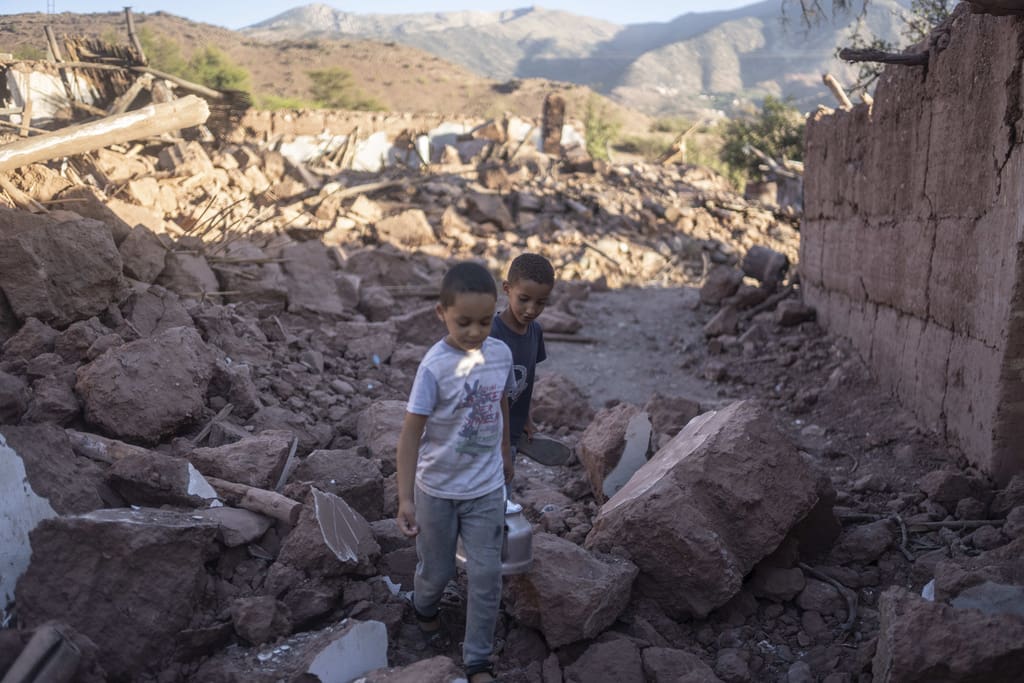MARRAKECH, Morocco — A rare, powerful earthquake struck Morocco, sending people racing from their beds into the streets and toppling buildings in mountainous villages and ancient cities not built to withstand such force. More than 2,000 people were killed, and the toll was expected to rise as rescuers struggled Saturday to reach hard-hit remote areas.
The magnitude 6.8 quake, the biggest to hit the North African country in 120 years, sent people fleeing their homes in terror and disbelief late Friday. One man said dishes and wall hangings began raining down, and people were knocked off their feet. The quake brought down walls made from stone and masonry, covering whole communities with rubble.
The devastation gripped each town along the High Atlas’ steep and winding switchbacks in similar ways: homes folding in on themselves and mothers and fathers crying as boys and helmet-clad police carried the dead through the streets.
Remote villages like those in the drought-stricken Ouargane Valley were largely cut off from the world when they lost electricity and cellphone service. By midday, people were outside mourning neighbors, surveying the damage on their camera phones and telling one another “May God save us.”
Hamid Idsalah, a 72-year-old mountain guide, said he and many others remained alive but had little future to look forward to. That was true in the short-term — with remnants of his kitchen reduced to dust — and in the long-term — where he and many others lack the financial means to rebound.
“I can’t reconstruct my home. I don’t know what I’ll do. Still, I’m alive, so I’ll wait,” he said as he walked through the desert oasis town overlooking red rock hills, packs of goats and a glistening salt lake. “I feel heartsick.”
In historic Marrakech, people could be seen on state TV clustering in the streets , afraid to go back inside buildings that might still be unstable. The city’s famous Koutoubia Mosque, built in the 12th century, was damaged, but the extent was not immediately clear. Its 69-meter (226-foot) minaret is known as the “roof of Marrakech.” Moroccans also posted videos showing damage to parts of the famous red walls that surround the old city, a UNESCO World Heritage site.
At least 2,012 people died in the quake, mostly in Marrakech and five provinces near the epicenter, Morocco’s Interior Ministry reported Saturday night. At least 2,059 more people were injured — 1,404 critically — the ministry said.
[read more]
“The problem is that where destructive earthquakes are rare, buildings are simply not constructed robustly enough to cope with strong ground shaking, so many collapse, resulting in high casualties,” said Bill McGuire, professor emeritus of geophysical and climate hazards at University College London.
In a sign of the huge scale of the disaster, Morocco’s King Mohammed VI ordered the armed forces to mobilize specialized search and rescue teams and a surgical field hospital, according to a statement from the military.
The king said he would visit the hardest hit area Saturday, but despite an outpouring of offers of help from around the world, the Moroccan government had not formally asked for assistance, a step required before outside rescue crews could deploy.
The epicenter of Friday’s tremor was near the town of Ighil in Al Haouz Province, roughly 44 miles south of Marrakech. Al Haouz is known for scenic villages and valleys tucked in the High Atlas Mountains.
World leaders offered to send in aid or rescue crews as condolences poured in from countries in Europe, the Middle East and the Group of 20 summit in India. The president of Turkey, which lost tens of thousands of people in a massive earthquake earlier this year, was among those proposing assistance. France and Germany, with large populations of people of Moroccan origin, also offered to help, and the leaders of both Ukraine and Russia expressed support for Moroccans.
In an exceptional move, neighboring rival Algeria offered to open its airspace to allow eventual humanitarian aid or medical evacuation flights to travel to and from Morocco. Algeria closed the airspace when its government severed diplomatic ties with Morocco in 2021 over a series of issues. The countries have a decades-long dispute involving the territory of Western Sahara.
The U.S. Geological Survey said the quake had a preliminary magnitude of 6.8 when it hit at 11:11 p.m. (22:11 GMT), with shaking that lasted several seconds. The U.S. agency reported a magnitude 4.9 aftershock hit 19 minutes later. The collision of the African and Eurasian tectonic plates occurred at a relatively shallow depth, which makes a quake more dangerous.
Earthquakes are relatively rare in North Africa. Lahcen Mhanni, Head of the Seismic Monitoring and Warning Department at the National Institute of Geophysics, told 2M TV that the earthquake was the strongest ever recorded in the region.
Friday’s quake was felt as far away as Portugal and Algeria, according to the Portuguese Institute for Sea and Atmosphere and Algeria’s Civil Defense agency, which oversees emergency response.
[/read]

